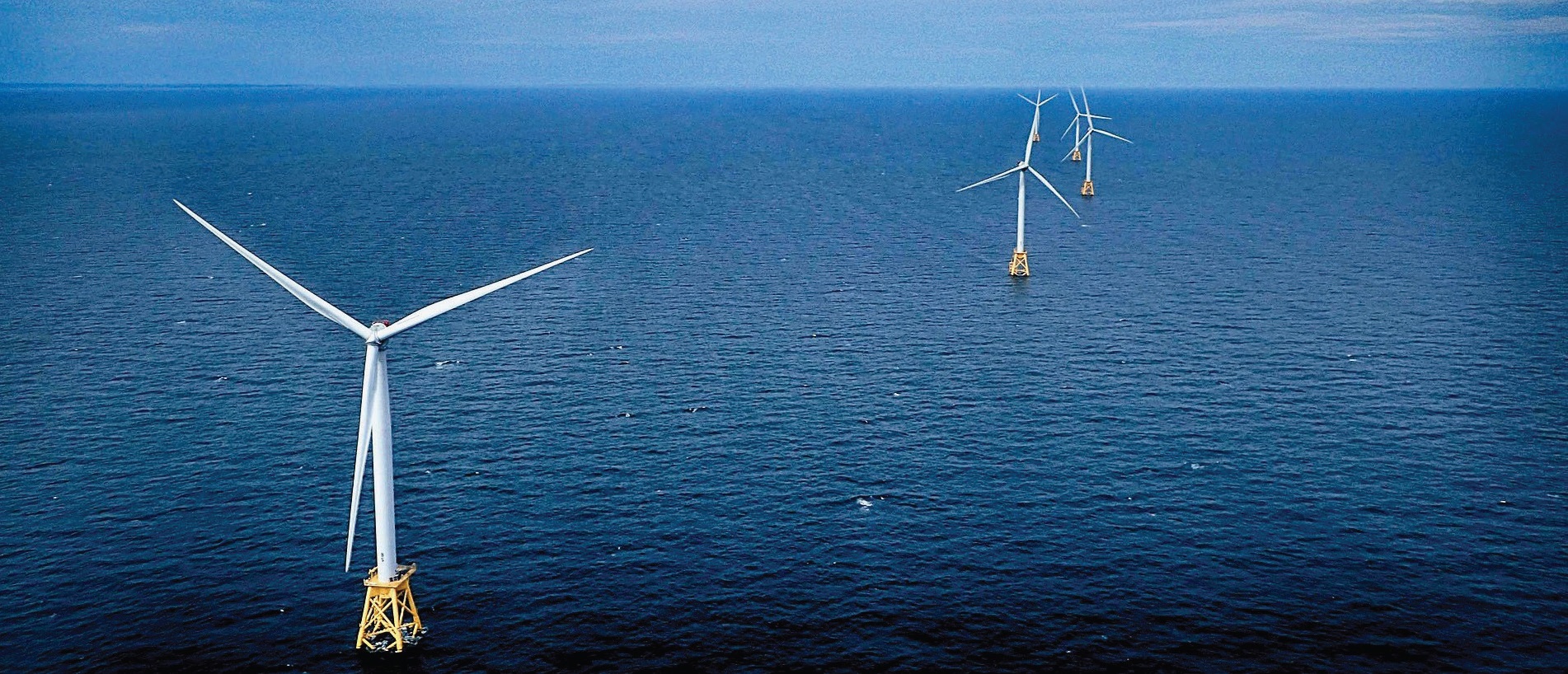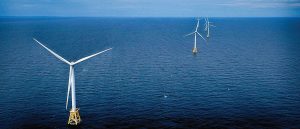Today, the White House convened leaders from across the administration to announce a set of bold actions that will catalyze offshore wind energy, strengthen the domestic supply chain, and create good-paying, union jobs.

National Climate Adviser Gina McCarthy, Interior Secretary Deb Haaland, Energy Secretary Jennifer Granholm, Commerce Secretary Gina Raimondo, and Transportation Secretary Pete Buttigieg met with state officials, industry executives, and labor leaders to announce new leasing, funding, and goals that employ President Joe Biden’s whole-of-government approach, position America to lead a clean-energy revolution, and create thousands of jobs across the country with the choice to join a union.
In his first week in office, President Biden issued an executive order that calls on the nation to build a new American infrastructure and clean-energy economy that will create millions of new jobs. In particular, the president’s order committed to expand opportunities for the offshore wind industry. The president recognizes that a thriving offshore wind industry will drive new jobs and economic opportunity up and down the Atlantic Coast, in the Gulf of Mexico, and in Pacific waters. The industry will also spawn new supply chains that stretch into America’s heartland, as illustrated by the 10,000 tons of domestic steel that workers in Alabama and West Virginia are supplying to a Texas shipyard where Dominion Energy is building the Nation’s first Jones Act compliant wind-turbine installation vessel.
Federal leadership, in close coordination with states and in partnership with the private sector, unions, and other key stakeholders, is needed to catalyze the deployment of offshore wind at scale.
The administration is taking coordinated steps to support rapid offshore wind deployment and job creation:
- Advance ambitious wind-energy projects to create good-paying, union jobs.
- Investing in American infrastructure to strengthen the domestic supply chain and deploy offshore wind energy.
- Supporting critical research and development and data-sharing.
Announcing a new wind-energy area
The Interior Department’s Bureau of Ocean Energy Management (BOEM) is announcing a new priority wind-energy area in the New York Bight — an area of shallow waters between Long Island and the New Jersey coast — that a recent study from Wood Mackenzie shows can support up to 25,000 development and construction jobs from 2022 to 2030, as well as an additional 7,000 jobs in communities supported by this development. The study indicates the New York Bight lease area also has the potential to support up to 4,000 operations and maintenance jobs annually and approximately 2,000 community jobs in the following years. This new wind-energy area is adjacent to the greater metropolitan Tri-State area — the largest metropolitan population center in the United States that is home to more than 20 million people and their energy needs. The next step is for BOEM to publish a proposed sale notice, followed by a formal public comment period and a lease sale in late 2021 or early 2022.
Establishing a target of employing thousands of workers to deploy 30 GW of offshore wind by 2030
The Departments of Interior (DOI), Energy (DOE), and Commerce (DOC) are announcing a shared goal to deploy 30 GW of offshore wind in the United States by 2030, while protecting biodiversity and promoting ocean co-use. Meeting this target will trigger more than $12 billion per year in capital investment in projects on both U.S. coasts, create tens of thousands of good-paying, union jobs, with more than 44,000 workers employed in offshore wind by 2030 and nearly 33,000 additional jobs in communities supported by offshore wind activity. It will also generate enough power to meet the demand of more than 10 million American homes for a year, and avoid 78 million metric tons of CO2 emissions.
DOI action to unlock deployment potential
To position the domestic offshore wind industry to meet the 2030 target, DOI’s Bureau of Ocean Energy Management (BOEM) plans to advance new lease sales and complete review of at least 16 construction and operations plans (COPs) by 2025, representing more than 19 GW of new clean energy for our nation.
Massive supply chain benefits of deploying offshore wind energy at scale
Meeting the 2030 target will catalyze significant supply chain benefits, including new port upgrade investments totaling more than $500 million; one to two new U.S. factories for each major wind-farm component including wind-turbine nacelles, blades, towers, foundations, and subsea cables; additional cumulative demand of more than 7 million tons of steel — equivalent to four years of output for a typical U.S. steel mill; and the construction of four to six specialized turbine installation vessels in U.S. shipyards, each representing an investment between $250 million and $500 million.
2050 implications of meeting the 2030 goal
Achieving this target also will unlock a pathway to 110 GW by 2050, generating 77,000 offshore wind jobs and more than 57,000 additional jobs in communities supported by offshore wind activity — all while creating further economic opportunity and ensuring future generations have access to clean air and abundant renewable power.
Advancing critical permitting milestones for the Ocean Wind offshore wind project
BOEM is announcing a notice of intent (NOI) to prepare an environmental impact statement (EIS) for Ocean Wind, putting it in line to become America’s third commercial scale offshore wind project. Ocean Wind has proposed an offshore wind project with a total capacity of 1,100 megawatts (MW) — enough to power 500,000 homes across New Jersey. BOEM previously announced environmental reviews for Vineyard Wind (Massachusetts) and South Fork (Rhode Island), and anticipates initiating the environmental reviews for up to 10 additional projects later this year.
Investing in port infrastructure to support offshore wind
The U.S. Department of Transportation’s (DOT) Maritime Administration announced a Notice of Funding Opportunity for port authorities and other applicants to apply for $230 million for port and intermodal infrastructure-related projects through the Port Infrastructure Development Program. Port infrastructure development grants support projects that strengthen and modernize port infrastructure and can support shore-side wind energy projects, such as storage areas, laydown areas, and docking of wind-energy vessels to load and move items to offshore wind farms. In addition to supporting the nation’s long-term economic vitality, DOT’s review process will consider how proposed projects can most effectively address climate change and environmental justice imperatives.
Access to $3 billion in debt capital to support offshore wind industry through DOE loan programs office
DOE’s loan programs office (LPO) released a fact sheet to facilitate access for the offshore wind industry for $3 billion in funding through LPO’s Title XVII Innovative Energy Loan Guarantee Program. The fact sheet signals that LPO is open for business and ready to partner with offshore wind and offshore transmission developers, suppliers, and other financing partners to scale the U.S. offshore industry and support well-paying jobs. To date, LPO has provided $1.6 billion in support of projects totaling about 1,000 MW of onshore wind.
Announcing offshore wind R&D funding through the National Offshore Wind R&D Consortium
The National Offshore Wind Research and Development Consortium (NOWRDC), created by the DOE and the New York State Energy Research and Development Authority (NYSERDA), is announcing the award of $8 million to 15 offshore wind research and development projects that were selected through a competitive process. The new projects will focus on offshore support structure innovation, supply chain development, electrical systems innovation, and mitigation of use conflicts that will help reduce barriers and costs for offshore wind deployment. The NOWRDC was established in 2018 with a $20.5 million DOE investment, matching funds from NYSERDA, and with follow-on contributions from state agencies in Maryland, Virginia, Massachusetts, and Maine — all resulting in a total investment of about $47 million.
Partnering with industry on data-sharing
The Department of Commerce’s National Oceanic and Atmospheric Administration (NOAA) is signing a memorandum of agreement with Ørsted, an offshore wind-development company, to share physical and biological data in Ørsted-leased waters subject to U.S. jurisdiction. This agreement is the first of its kind between an offshore wind developer and NOAA and paves the way for future data-sharing agreements that NOAA expects to enter into with other developers. NOAA anticipates that Ørsted’s and other companies’ data will fill gaps in ocean science areas — particularly in ocean mapping and observing — in service of NOAA’s mission to advance climate adaptation and mitigation, weather-readiness, healthy oceans, and resilient coastal communities and economies.
Studying offshore wind impacts
NOAA’s Northeast Sea Grant programs, in partnership with DOE, DOC, and NOAA’s Northeast Fisheries Science Center, is releasing a request for research proposals to support more than $1 million in grant funding to improve understanding of offshore renewable energy for the benefit of a diversity of stakeholders, including fishing and coastal communities. Grant funding will support objective community-based research in the Northeast to further understanding of the effects of offshore renewable energy on the ocean and local communities and economies as well as opportunities to optimize ocean co-use.
The American Clean Power Association (ACP) issued a statement after the Biden administration’s announcement, along with complementary initiatives to achieve the federal objective.
“This is an historic day for offshore wind energy in America,” said Heather Zichal, ACP CEO. “The Biden administration’s ambitious, but achievable, goal of 30 GW by 2030 sets the stage for a brand-new home-grown energy industry that will slash carbon emissions, create 83,000 American jobs, and add $25 billion in annual investments into our economy by the end of this decade. Creating a stable policy platform for offshore wind development and facilitating the first wave of significant projects will provide certainty for the industry, strengthen the workforce, and revolutionize domestic supply chains up and down the coasts and across the country. Now is the time to seize on this once-in-a-generation opportunity.”



























